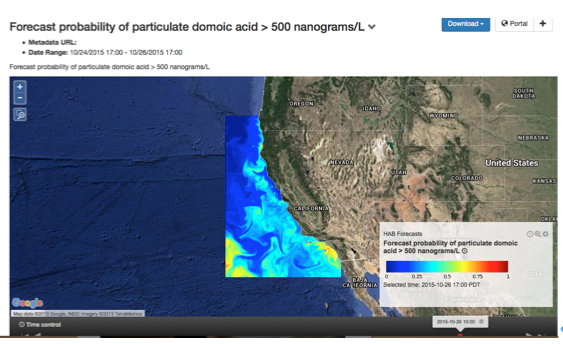My interest in harmful algal blooms dates back to my undergraduate years at UC Berkeley where I first learned about the mysteries surrounding Ciguatera Fish Poisoning at tropical latitudes, caused by a dinoflagellate called Gambierdiscus. The periodic and seemingly unpredictable nature of microscopic algae that could suddenly bloom and turn deadly captured my imagination then and now. My research since graduate school at UC Santa Barbara has focused on forecasting a different toxic phytoplankton here in coastal California, where despite previous beliefs, there is a good deal of predictability surrounding the environmental conditions that ‘select’ for certain species of harmful microalgae.
As we learn more about the diatom Pseudo-nitzschia and its neurotoxin, domoic acid, we are gaining a deeper appreciation for the complexity of phytoplankton ecology all the way down to the molecular level. Since I am an oceanographer, my training has helped me to view these dangerous blooms from many angles: chemistry, physics, and, of course, biology. The constant march of technological advancements now allows us to view algal blooms and (potentially) their toxic byproducts from space, observe them in the water in real-time, and capture the fine-scale physical processes involved. Using the many coastal observing and modeling platforms at our disposal, my colleagues and I have worked hard to implement a forecasting system for Pseudo-nitzschia blooms and toxic Domoic Acid events for California waters.

Having this capability in place took on new significance this year with the largest, most extensive bloom of Pseudo-nitzschia ever recorded. The bloom was observed from Santa Barbara to Alaska and lasted from May to August, closing important fisheries along the entire West Coast for many months. The toxin bioaccumulated with such ferocity into the tissues of marine animals that sardines and anchovies were off limits from fishing, sea lions were stranding in record numbers, and large marine mammals, such as fin whales, were washing ashore from domoic acid poisoning. My research will continue to work on improving the forecasting of these blooms in order to aid in the management of seafood resources and marine mammal protection, particularly as we face the potential for stronger, more toxic blooms in the future. Over the next several years, this forecasting system will become fully “operational” at NOAA’s National Weather Service and National Ocean Service in order to better serve the public.

